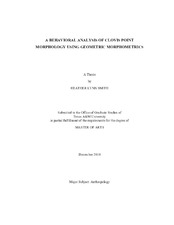| dc.contributor.advisor | Goebel, Ted | |
| dc.creator | Smith, Heather Lynn | |
| dc.date.accessioned | 2012-02-14T22:18:44Z | |
| dc.date.accessioned | 2012-02-16T16:13:37Z | |
| dc.date.available | 2012-02-14T22:18:44Z | |
| dc.date.available | 2012-02-16T16:13:37Z | |
| dc.date.created | 2010-12 | |
| dc.date.issued | 2012-02-14 | |
| dc.date.submitted | December 2010 | |
| dc.identifier.uri | https://hdl.handle.net/1969.1/ETD-TAMU-2010-12-8876 | |
| dc.description.abstract | This thesis presents an investigation into Paleoindian projectile-point morphology.
A goal of this research is to determine if evidence of a normative cultural manufacturing
protocol can be identified on Clovis projectile points which can then be used to address research questions concerning Clovis point variability, and ultimately, the spread of this tool-form across North America. This paper addresses obstacles to behavioral investigations of stone tool morphology such as the effects of resharpening and raw material type on tool shape. I argue that a culturally normative process of manufacture was maintained throughout the life-history of Clovis projectile points which translated into a specific shape maintained to the time of exhaustion and discard. As an analytical
tool, this study utilizes the geometric morphometric method to retain the geometry of each artifact throughout analysis by focusing on spatial covariation among landmarks uniformly found on each tool. This thesis investigates variability in 123 fluted projectile points from 23 archaeological sites in North America which met criteria meant to control for security of context in the archaeological record. Principle components describing the shape-variability inherent in this data-set were generated using geometric morphometrics and multivariate statistical analyses were employed to identify major factors of variability.
This research concluded that Clovis projectile-point shape was determined by normative cultural behavior maintained throughout the life of the artifact and not the result
of raw material type or resharpening processes. Therefore, the projectile-point variability
found to be geographically patterned provided evidence of Paleoindian movement and the spread of tool form. Multivariate analysis of variance determined that a regional trend in variability was present. The distribution of within-site variance suggested that artifacts from sites in the West were very homogeneous while artifacts from Eastern sites were more variable. The multivariate cluster and discriminant function analyses also demonstrated a closer affinity between artifacts in the Southwest and Northwest than either
has with the Northeast. The similarities in projectile point morphology between the Southwest and Northwest regions suggest movement beginning with a Southwest point of origin from which Pleistocene peoples may have carried their fluted point technology north and east. | en |
| dc.format.mimetype | application/pdf | |
| dc.language.iso | en_US | |
| dc.subject | Clovis | en |
| dc.subject | Geometric Morphometrics | en |
| dc.subject | fluted | en |
| dc.subject | projectile points | en |
| dc.subject | lithic | en |
| dc.subject | Paleoindians | en |
| dc.subject | First Americans | en |
| dc.title | A Behavioral Analysis of Clovis Point Morphology Using Geometric Morphometrics | en |
| dc.type | Thesis | en |
| thesis.degree.department | Anthropology | en |
| thesis.degree.discipline | Anthropology | en |
| thesis.degree.grantor | Texas A&M University | en |
| thesis.degree.name | Master of Arts | en |
| thesis.degree.level | Masters | en |
| dc.contributor.committeeMember | Waters, Michael | |
| dc.contributor.committeeMember | DeWitt, Thomas | |
| dc.contributor.committeeMember | Carlson, David | |
| dc.type.genre | thesis | en |
| dc.type.material | text | en |


